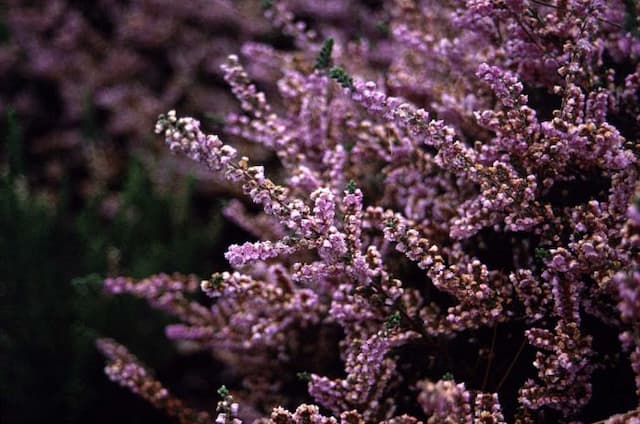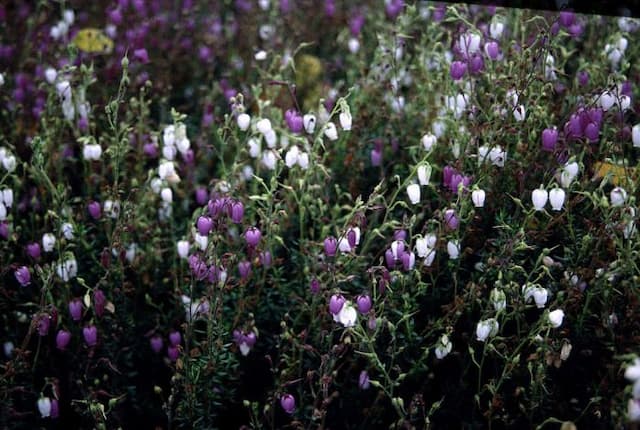Rhododendron 'Kirin' (Kurume) (Ea/d)

ABOUT
The Rhododendron 'Kirin', also commonly known as the Kurume Azalea, is a visually striking plant with a profusion of blooms. The flowers of the 'Kirin' azalea emerge in a remarkable display of color, typically presenting in shades of soft pink. These blossoms are funnel-shaped and often have a gentle ruffling along their edges, contributing to an appearance of delicate beauty. Each flower cluster is a dense, visually appealing arrangement that can add a burst of color to any garden. The foliage of the Kurume Azalea is also noteworthy, comprised of small, glossy leaves that provide a rich green backdrop to the vibrant flowers. In autumn, the leaves may turn to attractive bronze hues, offering year-round interest. The overall impression of the Rhododendron 'Kirin' is one of classic elegance, with its lush, vivid flowers contrasting beautifully against the evergreen foliage.
About this plant
 Names
NamesFamily
Ericaceae
Synonyms
Kurume Azalea, Kirin Azalea
Common names
Rhododendron 'Kirin'
 Toxicity
ToxicityTo humans
Rhododendron, including the 'Kirin' variety, contains toxic compounds called grayanotoxins which are poisonous to humans if ingested. Symptoms of rhododendron poisoning can include vomiting, diarrhea, hypersalivation, weakness, coma, hypotension, and potentially death due to cardiovascular collapse.
To pets
Rhododendron is toxic to pets as well. If a pet ingests any part of this plant, it can experience symptoms similar to those in humans, such as vomiting, diarrhea, drooling, weakness, and in extreme cases, seizures, coma, and even death due to respiratory failure or cardiovascular collapse.
 Characteristics
CharacteristicsLife cycle
Perennials
Foliage type
Evergreen
Color of leaves
Green
Flower color
Pink
Height
3 feet (91 cm)
Spread
3 feet (91 cm)
Plant type
Shrub
Hardiness zones
5
Native area
Japan
Benefits
 General Benefits
General Benefits- Aesthetic Appeal: Rhododendron 'Kirin' adds vibrant color to landscapes with its stunning pink flowers which bloom in abundance.
- Compact Size: With a smaller growth habit, this variety fits well in limited spaces or as part of a mixed border.
- Low Maintenance: It requires minimal pruning and upkeep once established, making it ideal for gardeners of all skill levels.
- Drought Tolerance: Once established, it can tolerate periods of dryness, reducing the need for frequent watering.
- Cold Hardy: This rhododendron variety can withstand cold temperatures, making it suitable for a variety of climates.
- Wildlife Attraction: The flowers attract pollinators like bees and butterflies, supporting local ecosystems.
- Seasonal Interest: Provides colorful blooms in spring and evergreen foliage throughout the year.
- Tolerant of Acidic Soils: 'Kirin' thrives in acidic soil conditions, which can be beneficial in regions with this soil type.
- Versatility: Can be used in a variety of landscaping designs, from woodland gardens to formal planting schemes.
 Medical Properties
Medical PropertiesThis plant is not used for medical purposes.
 Air-purifying Qualities
Air-purifying QualitiesThis plant is not specifically known for air purifying qualities.
 Other Uses
Other Uses- Rhododendron 'Kirin' can be employed in bonsai cultivation, where its small leaves and vibrant flowers make for a visually appealing miniature tree.
- Gardeners may use the fallen petals of the Rhododendron 'Kirin' to create natural, colorful mulch that adds aesthetic value while protecting soil moisture.
- This plant's wood can be carved into small decorative items or jewelry, utilizing the harder wood of mature branches.
- Rhododendron 'Kirin' can sometimes be used in butterfly gardens, as the flowers may attract butterflies and other pollinators.
- The plant has potential use in educational settings, teaching students about plant biology, taxonomy, and hybridization due to its status as a cultivar.
- Florists might use stems of Rhododendron 'Kirin' with buds and blooms in cut flower arrangements for a temporary display of their vibrant colors.
- The dense foliage of Kirin can provide shelter for small wildlife, such as birds, by creating a protective canopy in garden settings.
- In textile dyeing, petals or extracts from Rhododendron 'Kirin' could be researched as a natural dye source.
- As a subject in photography, the vivid blooms and the overall plant structure offer aesthetic appeal and are often featured in gardening magazines.
- People might use Rhododendron 'Kirin' as part of maze garden designs or as a natural fencing alternative, given its dense growing habit.
Interesting Facts
 Feng Shui
Feng ShuiThe Rhododendron is not used in Feng Shui practice.
 Zodiac Sign Compitability
Zodiac Sign CompitabilityThe Rhododendron is not used in astrology practice.
 Plant Symbolism
Plant Symbolism- Caution: Rhododendrons, including the 'Kirin', symbolize caution due to their toxicity. Historically, they serve as a reminder to be cautious about what is beautiful, as not everything that looks appealing is safe.
- Beware: Similarly to caution, rhododendrons are often associated with the concept of "beware". This connects to their poisonous nature and the idea that one should be wary of potential dangers even in attractive packages.
- Abundance: These plants are known for their vibrant blooms and lush foliage, representing an overflow of beauty and an abundance of positive feelings.
- Elegance: The rhododendron, with its stunning flowers and regal presence, is frequently seen as a symbol of elegance and sophistication.
- Wealth: Due to its lavish appearance, the rhododendron can be symbolic of prosperity and wealth.
 Water
WaterKurume azaleas should be watered deeply and thoroughly, ensuring the soil is moist but not soggy. During the active growing season, typically spring and summer, they may require watering every 7-10 days, depending on the climate and weather conditions. In hot, dry periods, more frequent watering may be necessary, while in cooler, rainy seasons, less frequent watering is required. Aim to provide about 1 inch of water per week, which translates to roughly 0.6 gallons per square foot of soil area, ensuring you adjust based on rainfall and temperature. Overhead watering should be avoided to prevent fungal diseases; instead, apply water directly to the base of the plant.
 Light
LightKurume azaleas thrive best in partial shade with filtered sunlight or in a spot that receives morning sun and afternoon shade. Avoid planting them in deep shade or full sun, as too little light can lead to poor flowering and too much sun can scorch their leaves and cause stress to the plant. An ideal location would be under the canopy of tall trees that allows dappled sunlight to reach the azaleas, creating a suitable environment for robust growth and blossoming.
 Temperature
TemperatureKurume azaleas are hardy and can withstand a range of temperatures but perform best in cooler conditions. They can survive minimum winter temperatures down to about 0°F and can handle maximum summer temperatures of around 80°F to 90°F. The ideal temperature range for Kurume azaleas to flourish is between 60°F and 70°F, and it's essential to protect them from extreme heat or frost to maintain their health and enhance blooming.
 Pruning
PruningPruning Kurume azaleas is necessary to maintain their shape, remove dead or diseased wood, and encourage bushier growth and better flowering. The best time to prune is immediately after the blooms fade in spring, as pruning later in the season can remove next year's flower buds. Lightly shape the azaleas, being careful not to cut into old wood where new growth is limited. Pruning every year or every other year is typically sufficient to keep Kurume azaleas looking their best.
 Cleaning
CleaningAs needed
 Soil
SoilFor the best growth of Kurume Azalea, the soil mix should be well-draining, high in organic matter, and have a pH of 4.5 to 6.0. A mixture of pine bark, peat moss, and perlite or sand at equal ratios is ideal for potting.
 Repotting
RepottingKurume Azalea should be repotted every 2 to 3 years, preferably in spring just before new growth begins to ensure minimal stress on the plant.
 Humidity & Misting
Humidity & MistingKurume Azalea thrives in moderate to high humidity levels, ideally around 60-80%. Consistent humidity is crucial for its vibrant blooms and health.
 Suitable locations
Suitable locationsIndoor
Place Kurume Azalea near bright, filtered light indoors, away from dry air sources.
Outdoor
Plant in dappled shade with moist, acidic soil outdoors for optimal growth.
Hardiness zone
6-9 USDA
 Life cycle
Life cycleThe life cycle of the Rhododendron 'Kirin', commonly known as Kurume Azalea, begins with seed germination in a moist, well-drained, acidic soil environment. The seedlings emerge and establish themselves, developing into juvenile plants with a set of true leaves. As they mature, they form woody stems and a bushy habit, typically reaching blooming maturity in a few years. The Kurume Azalea produces abundant clusters of pink, trumpet-shaped flowers each spring, attracting pollinators for sexual reproduction. Following pollination and fertilization, seed capsules develop and, once ripe, disperse seeds for the next generation. The plant continues to grow and flower annually, and with proper care, can have a lifespan of several decades.
 Propogation
PropogationPropogation time
Spring
Propogation: The most popular method of propagation for the Rhododendron 'Kirin' is through semi-hardwood cuttings, typically taken in the late summer. To effectively propagate, a 4 to 6 inch (10 to 15 cm) cutting from the current year's growth is selected. The leaves on the lower half of the cutting are removed, and the cut end is dipped into a rooting hormone before it is planted in a mixture of peat and perlite or a well-draining potting mix. The cutting is then placed in a warm, humid environment, ensuring that the soil remains consistently moist but not waterlogged. To maintain the humidity, the cutting can be covered with a plastic bag or placed in a propagator, until roots have developed, which generally takes several weeks to a few months. Once the cutting is well-rooted, it can be potted on into a larger container or planted directly into the garden.









